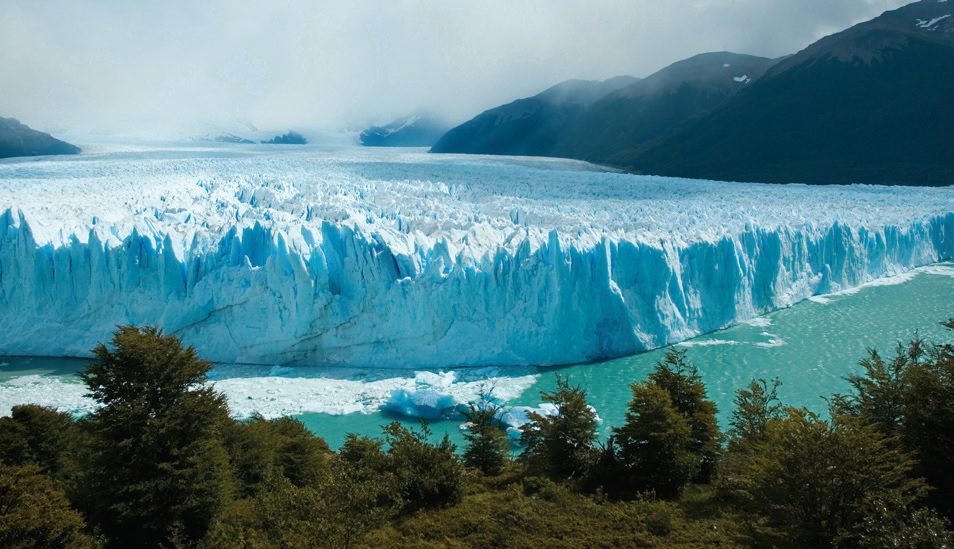How friction affects glacier speed
R. David Whitby | TLT Worldwide March 2019
Ice at the bottom moves more slowly than ice at the top in these gigantic land masses.

Glaciers cover about 10% of Earth’s land surface.
© Can Stock Photo / elnavegante
I wrote about motorists’ experiences with snow and ice and friction in the
May 2010 TLT. Glaciers and friction are different.
A glacier is an enduring accumulation of dense ice that is moving constantly under its own weight. They form only on land where falls of snow exceed the rate of melting and sublimation over many years. Glaciers often are described as rivers of ice. They also abrade rock and debris over which they move.
Most glacial ice is found in huge ice sheets in the polar regions, but glaciers are found in mountain ranges on every continent. Glaciers cover about 10% of Earth’s land surface and are the largest reservoir of fresh water. Many glaciers from temperate, alpine and seasonal polar climates store water as ice during the winter and release it as meltwater in summer. Glacial mass is affected by long-term variations in temperature such as precipitation and cloud cover. Mass changes are considered among the most sensitive indicators of climate change and are a major source of variations in sea level.
The top 50 meters of a glacier is rigid because it is under low pressure. This upper section, known as the fracture zone, moves mostly as a single unit over the plastically flowing lower section. When a glacier moves through irregular terrain, cracks called crevasses develop in the fracture zone due to the shear forces between two rigid sections moving at different speeds and directions.
The speed of glacial movement is partly determined by friction, since ice at the bottom of the glacier moves more slowly than ice at the top. In alpine glaciers, friction also occurs at the valley’s side walls, which slows the edges relative to the center. Average speeds vary greatly but are generally about a meter a day. Velocity increases with increasing slope, increasing thickness, higher snowfall, greater longitudinal confinement, higher basal temperature, increasing meltwater production and lower bed hardness.
A few glaciers have periods of very rapid advancement, called surges. These glaciers move normally until they accelerate suddenly then return to their previous movement. A surge may be caused by failure of the underlying bedrock, the pooling of meltwater at the base of the glacier or a greater accumulation of ice. Temporary speeds of up to 90 meters a day have occurred when increased temperature or overlying pressure caused bottom ice to melt and water to accumulate beneath a glacier.
The Greenland ice sheet is the second largest ice body in the world, after the Antarctic ice sheet. It is almost 2,400 km in a north-south direction and 1,100 km wide near its northern margin. It is generally more than two km thick and more than three km at its thickest point. If the entire 2,850,000 cubic km of ice were to melt, it would lead to a global sea level rise of 7.2 meters during 14,000 years at current rates of melting.
Glacial movement at the edges of the Greenland ice sheet appears to be accelerating. Two mechanisms have been postulated to explain the change in velocity. The first is the enhanced meltwater effect caused by higher surface melting, funnelled through moulins (holes) reaching the glacier base and reducing friction through a higher basal water pressure. (Not all meltwater is retained in the ice sheet and some moulins drain into the ocean.)
The second mechanism is a force imbalance at the calving front due to thinning, causing a substantial non-linear response. An imbalance of forces at the calving front propagates back up the glacier. Thinning causes the glacier to be more buoyant, reducing frictional back forces, as the glacier becomes more afloat at the calving front. The reduced friction due to greater buoyancy allows for an increase in velocity. This is similar to letting off the emergency brake a little. For ice streaming sections of large outlet glaciers (in Antarctica as well), there is always water at the base of the glacier that helps lubricate the flow. An examination of 32 outlet glaciers in southeast Greenland indicates that the acceleration is significant only for glaciers that calve into the ocean.
Increased melting and faster calving of the Greenland ice sheet, due to climate change, should be of concern to almost everyone.
David Whitby is chief executive of Pathmaster Marketing Ltd. in Surrey, England. You can reach him at pathmaster.marketing@yahoo.co.uk.